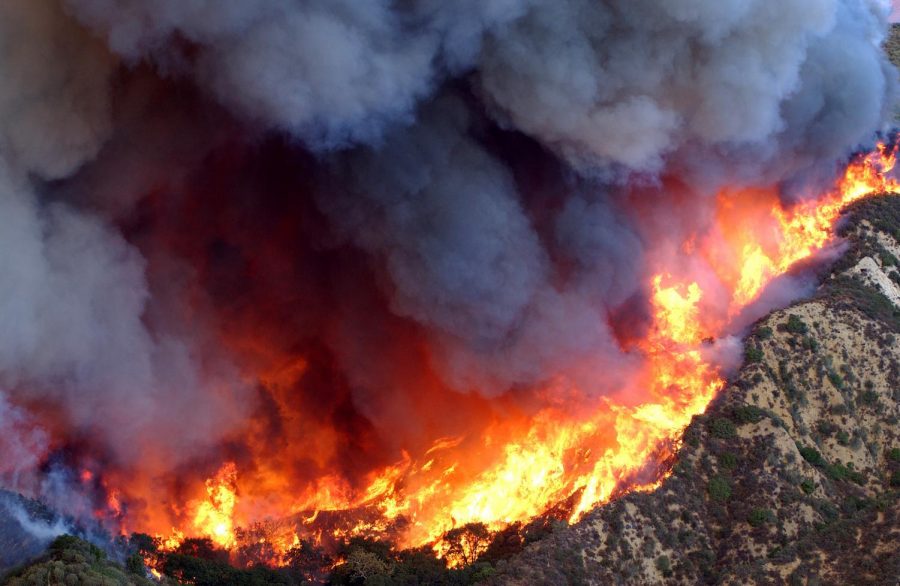Wild West Coast Flames
The state of California is being eaten alive by this year’s wildfires, but this is not new. Wildfires have been an ongoing historical natural disaster in the Golden State.
December 25, 2017
Imagine everything you know and own going up in flames. Imagine frantically struggling to find friends and loved ones in thick, smoky air that is slowly damaging your lungs in the long term. This has been reality for residents in Northern and Southern California in recent weeks. All together, these uncontainable fires are the size of New York City, and have transformed people’s lives for the worse.
The Thomas Fire is an enormous wildfire running through the counties of Ventura and Santa Barbara. Specifically, it has affected the cities of Ventura, Ojai, and Santa Paula. The Thomas Fire is just one of the many wildfires that began this month in Southern California. “I’m just standing here watching my life go up in flames,” said Escondido resident Kathie Browning on KPBS News, as she watched her family’s home burn to the ground. “This is just too unbelievable. This can’t be happening to me.”
These colossal and uncontrollable fires have been extremely destructive, have left some homeless, and have interrupted day-to-day life, including those of college students. According to Nick Roll’s article for Inside Higher Ed News, the wildfires have disrupted the lives of college students because of the cancellation of classes and final exams. At Saint Thomas Aquinas College, a private liberal arts college in Santa Paula, near the heart of the Thomas Fire, students and staff were evacuated. “We’re facing a new reality in this state, where fires threatened people’s lives, their properties, their neighborhoods and billions and billions of dollars, so we have to have the resources to combat the fires,” California governor Jerry Brown said in the Los Angeles Times.
Firefighters are struggling to battle the fires. “If it’s this big and blowing with as much wind as it’s got, it’ll go all the way to the ocean before it stops,” said San Diego Fire Capt. Kirk Humphries on CBS News. “We can save some stuff, but we can’t stop it.” While the fire departments are trying their best—giving their biggest efforts, and risking their lives—to prevent the fire from continuing to spread, these fiery fiascos have grown out of their control.
Some may wonder, how do these wildfires develop? It is California’s combination of hot and dry weather, with its warm, gusting winds from the desert that allow “the perfect storm” to begin. The high winds also help the fire rapidly spread to surrounding towns and counties, making it harder for fire departments to keep the fires contained.
But these fires are nothing out of the ordinary. According to NBC News, California is disaster-prone. Doug Whitman explains that some of the most common natural disasters California experiences in addition to wildfires are landslides, floods, tsunamis, and earthquakes. According to the New York Times, in 1933, California experienced its deadliest wildfire to date, killing 29 people. This year’s wildfires in Northern California have surpassed that fire as the deadliest in history, as they have taken the lives of 35 residents, and, according to NBC News, have destroyed 8,400 homes and buildings.
The health of both victims and rescue teams have been put at risk. The combination of strong winds and thicks layers of smoke have formed an unhealthy environment for firefighters and residents. According to CBS News, wildfire smoke consists of “carbon monoxide, volatile organic carbon, and particles that include alkaline ash, black carbon, and organic carbon, which usually contains polyaromatic hydrocarbon, a cancer-causing agent.” The longer people are exposed to polluted air, the more likely they are to develop smoke-related illnesses, such as lung cancer, emphysema, and chronic bronchitis. The Los Angeles Times reports that county health officials from Santa Barbara are issuing masks and recommend that residents relocate for a couple of hours each day to alleviate their lungs.
People can help California’s residents who are in danger by following social media platforms—Facebook, Instagram, and Twitter—that are constantly posting numbers to text to or websites to donate to. You can support the United Way of Ventura County (http://vcunitedway.org), the Los Angeles Fire Department (http://supportlafd.org/donate/), and GoFundMe campaigns (https://www.gofundme.com/official-s-ca-fire-relief-fund/donate?pc=ot_dn_topics_w_11).

















































































































































